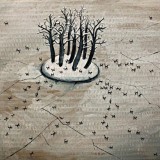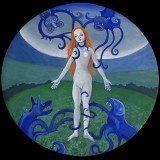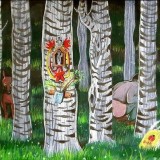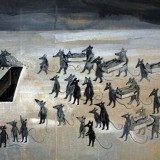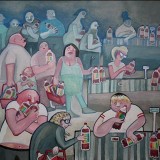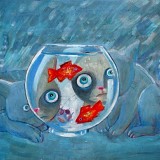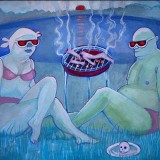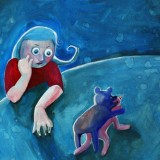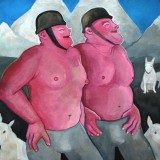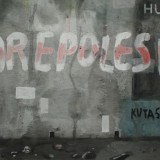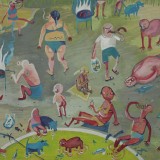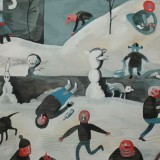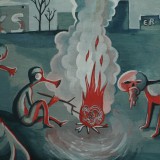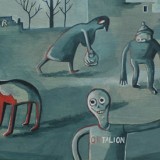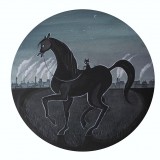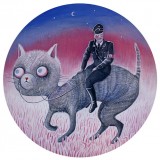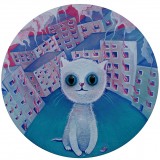Maria Apoleika
She is fascinated – and as a result of that so are we – in that which slips out of normality, which is apocalyptic and funny at the same time so bizarre and ugly that it’s beautiful and maybe through its strangeness – valuable.
Maria Apoleika (b. 1986) paints, draws, photographs, devises installation, animation and video art. Some of her works, especially those in the medium of film, are created together with a video artist called Marcello Zamenhoff, who is also leader of the Mikrowafle band and an active figure in the alternative £ód¼ scene.
Maria Apoleika is a student of the TV and Theatre School in the department of camera operating, where she is specialising in animation. This technique is reflected in the form of her drawings and paintings – they are illustrative, created with the use of contour and tell mysterious stories.
As she says, she looks for an inspiration in front of the computer, browsing through illustrations of old prints which she finds on the blog Bibliodyssey and in the Polona National Library. She also finds inspiration from watching gifs with cats or web portals with Russian fairy tales. By deriving inspiration from these slightly contaminated sources she creates her micro-world which is a version of “kawaii” aesthetics (popular in Japan) in a melancholic and jestingly macabre Eastern European version.
She paints however in a traditional tempera on wood technique. Very often her works have a tondo shape which evokes associations with religious paintings, although a large amount of her drawings are also created on accidental backgrounds such as cardboard, plywood, planks, walls of abandoned buildings. The characters painted in detail and placed in the centre resemble those images from folk, religious or decorative paintings. Naïve painting with its emotional aspect, folk wisdom and fatalism appears to be very close to her.
Instead of saints and scenes from their lives, her heroes are most often animals. She paints a great feeling of sadness during a funeral of small mice, ermine crying with bloody tears, a siren straying into a fish soup, cunning little foxes, an innocent looking kitten playing with matches against the background of a panorama with burning skyscrapers. In her private beast-catalogue there are long-hair guinea pigs, an aksolotl, sea bears, a pink elephant who watches bones. Thanks to them, her paintings are filled with soft, although sometimes soaked furs, but also claws, sharp teeth and, let’s not hide it, bad intentions. She paints “her own” animals with great empathy. It can be seen that they are beautiful, funny and touching to her. The way they are presented, full of care and engagement evokes associations with Hieronymus Bosch. The images of animals on the margins of his paintings are maybe not as excellent anatomically as on Dürer’s aquarelles, but there is the appearance of full of for at their small stories which are also the stories of all living people.
In general, if one would like to find a period in art history in which Maria Apoleika could find spiritual relatives, it would have been the late middle ages, with its stunning illuminations (the direct influence of for example the Limburg Brothers can be seen in such works as St. Catherine of Siena or Mandragora) and through the amazing pieces of flora and fauna and wittingly moralistic painting of the north Renaissance. And not only Hieronymus Bosch, also Peter Breughel Senior. It is escpecially visible in the last series of paintings devoted to the inhabitants of the neighbourhood where the artist’s studio is located on St. George’s St., which is Polesie in £ód¼. “Polesie is a collection of neglected tenant houses, garages, annexes and above all – Inhabitants. (…) Their lives thrives among the vertical slums of one hundred year old houses, numerous scrap metal shops, drinking haunts, bushes and dirty yards. They yell, lay down, drink, sing, trade, “live” – says the artists in an interview which accompanied one of the exhibitions. These inhabitants with their urban folklore consisting of cheap wine, barbecuing, wearing a shell tracksuit, making love in the bushes and sun bathing on the banks of the city pond, was portrayed by the artist in the Breughel-like streaming panoramas.
So although her paintings are so unique, she belongs to a larger family of people who find a constant food for the imagination in what may seem common.
Marta Sk³odowska


